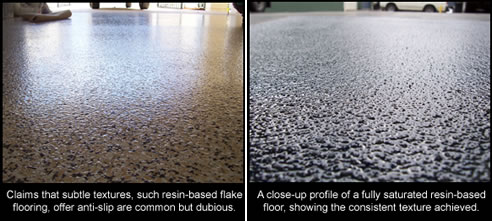NEWS ARTICLE ARCHIVESAnti-Slip Flooring with FLOORChef #Resin-basedOption
A one-minute article to stop slipping up At the end of our last article (#Planning) we finally got around to the question of which anti-slip flooring to use. Like most applications, the answer unremarkably comes down to whatever system is the best fit. Should that point you in the direction of resin-based anti-slip flooring, having a grasp of the basics will help make sure good decisions are made within this field. It sounds easy, but... In the simplest of terms, creating a slip-resistant surface with resins involves the application of a coating and the broadcast of a particle on top of it (or aggregate, as it may be known). It sounds foolproof enough, however the irony is that resin-based anti-slip flooring is quite difficult to master; slapping on any old product and tossing a heap of sand over it generally isn't the answer. There's a bit that goes into the design of a resin-based anti-slip floor and it starts with the basecoat. All the usual good qualities are relevant to ensure the system is anchored well - crosslinked (thermoset coatings rather than thermoplastic paints), strong adhesion, moisture tolerance etc. - however, in an anti-slip context the application thickness and its viscosity take on extra importance as well. The aim is to use the right product at the right film thickness to encapsulate the particle just enough (too much coverage won't provide enough texture, too little and particles can "pop out"). Full particle saturation and two coats The choice of particle and how it's used also demands close attention. You'll read more on selection in the next article, but in terms of usage it's typically a question of whether a full broadcast or a controlled sprinkle is employed. Our philosophy is to saturate the film wherever possible because it's the only way you can guarantee an even distribution with a consistent level of slip resistance. Also, saturation allows the wear to be shouldered by the particle rather than the resin, which means the floor will withstand a lot more punishment. A couple of final tips; firstly, a two-coat system is generally your best bet. While you can create an anti-slip floor with one coat and some aggregate, using two coats with about 60% particle coverage will result in a floor that's sealed better, comparatively easy to clean and holds up much longer. Secondly, don't get fooled by systems promoting flakes or roller textures in the finish as "non-slip". In our opinion, they don't offer consistent, long-term anti-slip properties. If you have any questions about resin-based anti-slip flooring, please don't hesitate to contact me directly. Keep Smiling,
Jack Josephsen For more articles on anti-slip flooring, visit the YESChef! Blog |
 |
 |